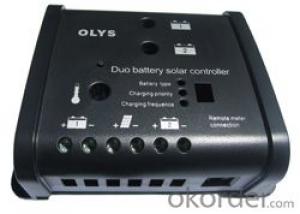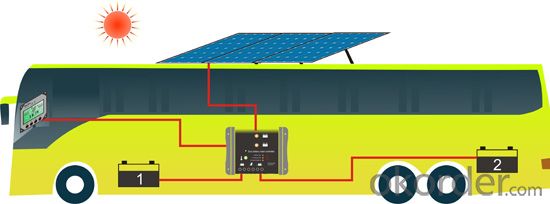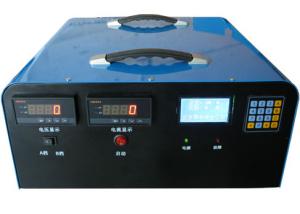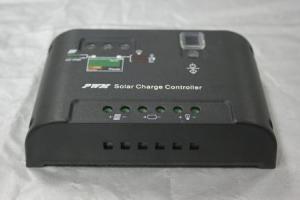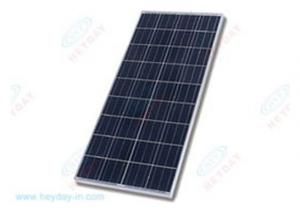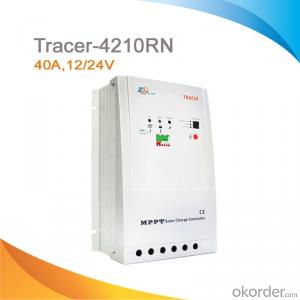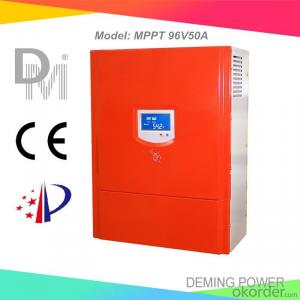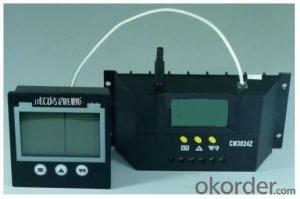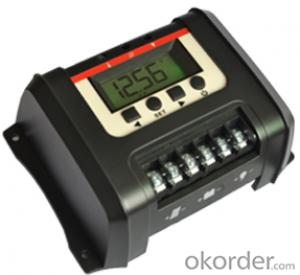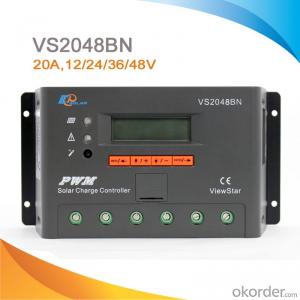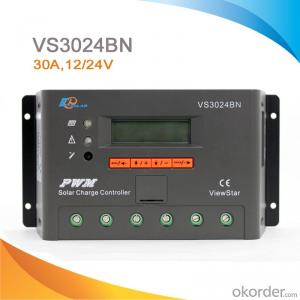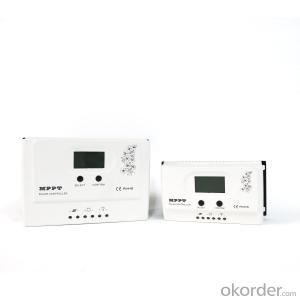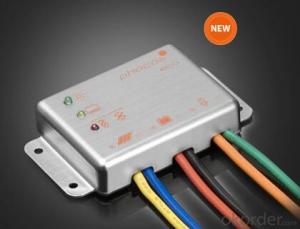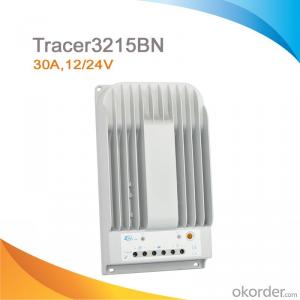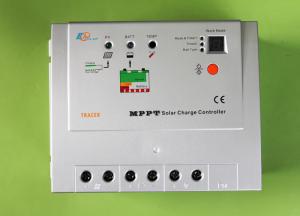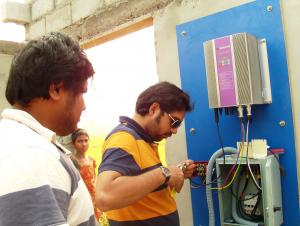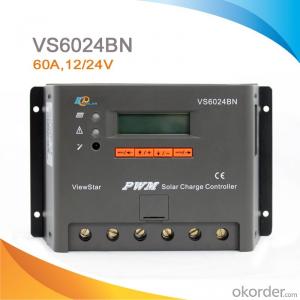One Solar Charge Controllers:RV Solar Power Controller with LCD Display & Remote Meter (Options)
- Loading Port:
- Shekou
- Payment Terms:
- TT OR LC
- Min Order Qty:
- 100 unit
- Supply Capability:
- 100000 unit/month
OKorder Service Pledge
OKorder Financial Service
You Might Also Like
1.The controller is ideal for use with motorhomes, caravans, boats or anywhere there are two independent batteries for instance a starter battery and a leisure battery.
2.Optional LCD Remote meter, you can monitor the charging parameter visual.
3.Automatic recognize 12V or 24V system.
4.The Charging percentages for each battery can be set manually if required.
5.PWM charging, high precision temperature compensation
6.Over charging, short-circuit, reverse polarity & reverse current to PV Protection
Technical data
Float voltageMODEL SDC10 SDC20 Maximum charge current 10A 20A Regulation voltage Automatic recongnize 12V/24V battery type Sealed battery Gel battery Flooded battery regulate voltage 14.2V 14.4V 14.6V Boost voltage 14.4V 14.6V 14.8V 13.7V 13.7V 13.7V Maximum solar voltage 30V Battery voltage range 1-15V Self-consumption 4mA at night, 10mA at charging Metebus connection 8PIN RJ45, 10m Temp.compensation -30mV Terminals 4mm2 temperature -35℃~55℃ Dimension 136.6×104.6×43.4mm weight 0.2kg(main), 0.15kg (remter) IP IP22
All the data is for 12V, For 24V, use 2×
- Q: Can a solar controller be used with a solar-powered water pump?
- Yes, a solar controller can be used with a solar-powered water pump. A solar controller is a device that regulates the flow of electricity from the solar panels to the connected load, in this case, the water pump. It ensures that the pump receives the right amount of power and provides protection against overcharging or overloading. Therefore, using a solar controller with a solar-powered water pump is essential for optimizing performance and prolonging the lifespan of the system.
- Q: How do I ensure proper ventilation for a solar controller installation?
- To ensure proper ventilation for a solar controller installation, it is important to place the controller in a well-ventilated area. This can be achieved by installing the controller in a location with adequate airflow, away from direct sunlight or heat sources. Additionally, leaving enough space around the controller for air circulation and avoiding any obstructions will help maintain proper ventilation.
- Q: How does a solar controller handle battery capacity monitoring?
- A solar controller handles battery capacity monitoring by measuring the voltage and current going in and out of the battery. It constantly monitors the battery's state of charge and adjusts the charging and discharging rates accordingly to prevent overcharging or deep discharge, ensuring optimal battery performance and longevity.
- Q: What is the maximum temperature a solar controller can withstand?
- The maximum temperature a solar controller can withstand varies depending on the specific model and manufacturer. However, in general, most solar controllers can typically handle temperatures up to around 60-70 degrees Celsius (140-158 degrees Fahrenheit) without any issues.
- Q: Can a solar controller be used with solar panel roof mounts?
- Yes, a solar controller can be used with solar panel roof mounts. The solar controller is responsible for regulating the charge from the solar panels to the batteries, ensuring optimal performance and preventing overcharging. The roof mounts, on the other hand, are used to securely fasten the solar panels to the roof. These two components work together to efficiently harness solar energy and provide power to the desired system.
- Q: What brand of solar controller is good
- Do you ask the controller for photovoltaic power generation?
- Q: Can a solar controller be used with solar panels of different orientations?
- Solar panels of different orientations can indeed be used with a solar controller. The solar controller's role is to regulate the energy flow between the solar panels and the battery or load, and this is unaffected by the panels' orientation. Monitoring the battery's charge level and preventing overcharging or discharging are the primary functions of the solar controller. Therefore, as long as the solar panels are connected to the controller and it is correctly set up, it can effectively manage the energy flow regardless of the panels' orientations. It is worth mentioning, however, that the efficiency of the solar panels may vary depending on their orientation towards the sun, which can impact the overall performance of the solar system.
- Q: Can a solar controller be used in a community solar system?
- Yes, a solar controller can be used in a community solar system. A solar controller is responsible for regulating the flow of electricity from the solar panels to the battery bank, ensuring optimal charging and preventing overcharging or damage to the batteries. In a community solar system, multiple solar panels are connected to a shared battery bank, and a solar controller is essential to efficiently manage the power generation and storage.
- Q: How do I calculate the required battery capacity for a solar controller?
- To calculate the required battery capacity for a solar controller, you need to consider a few key factors. Here's a step-by-step process to help you determine the appropriate battery size: 1. Determine your energy needs: Start by calculating the total energy consumption of the devices or systems that will be powered by the solar controller. This can be done by identifying the power consumption (in watts) and the daily usage (in hours) of each device. 2. Account for system losses: It's important to account for energy losses that occur during the conversion and storage process. Consider the efficiency ratings of the solar panels, charge controller, and battery. Typically, a 10-20% buffer is recommended to compensate for these losses. 3. Calculate daily energy requirement: Multiply the power consumption (in watts) of each device by the daily usage (in hours) to get the daily energy requirement for each device. Sum up these values to find the total daily energy requirement. 4. Account for energy autonomy: Determine how many days you want your system to operate without sunlight. Multiply the daily energy requirement by the number of days of autonomy to calculate the total energy storage needed. 5. Adjust for battery efficiency: Batteries have a certain efficiency rating, typically around 80-90%. To account for this, divide the total energy storage needed by the battery efficiency to determine the required battery capacity. 6. Consider depth of discharge (DoD): It's essential to avoid discharging batteries completely, as it can reduce their lifespan. Determine the maximum depth of discharge acceptable for your battery type (e.g., 50%), and multiply the required battery capacity by the reciprocal of the DoD to get the minimum recommended battery capacity. 7. Add safety margin: To ensure optimal performance and account for any unforeseen factors, it's advisable to add a safety margin of 10-20% to the calculated battery capacity. By following these steps and considering the various factors involved, you can accurately calculate the required battery capacity for your solar controller. Remember to consult the manufacturer's specifications and recommendations for your specific solar controller and battery type for precise calculations.
- Q: Can a solar controller be used with different types of solar panel shading systems?
- Yes, a solar controller can be used with different types of solar panel shading systems. The main function of a solar controller is to regulate the flow of electricity between the solar panels and the battery or grid. It does not specifically depend on the type of solar panel shading system being used. Whether you have a fixed tilt, single-axis, or dual-axis solar panel shading system, a solar controller can still be utilized to optimize the energy generation and protect the batteries from overcharging. However, it is important to ensure that the solar controller is compatible with the specific voltage and current requirements of your solar panel system.
Send your message to us
One Solar Charge Controllers:RV Solar Power Controller with LCD Display & Remote Meter (Options)
- Loading Port:
- Shekou
- Payment Terms:
- TT OR LC
- Min Order Qty:
- 100 unit
- Supply Capability:
- 100000 unit/month
OKorder Service Pledge
OKorder Financial Service
Similar products
Hot products
Hot Searches
Related keywords
